Have you been on the lookout for a natural, gentle solution for pain, inflammation, or just a bit of tender love and care for your skin? Here is a super simple, yet incredibly effective, recipe to create your own cannabis salve at home. Discover their many benefits, from easing aches and pains to kissing goodbye to dry, itchy skin. Plus, with easy alternative options and tips on where to purchase salve, you’re all set for a smoother, more serene skin experience.
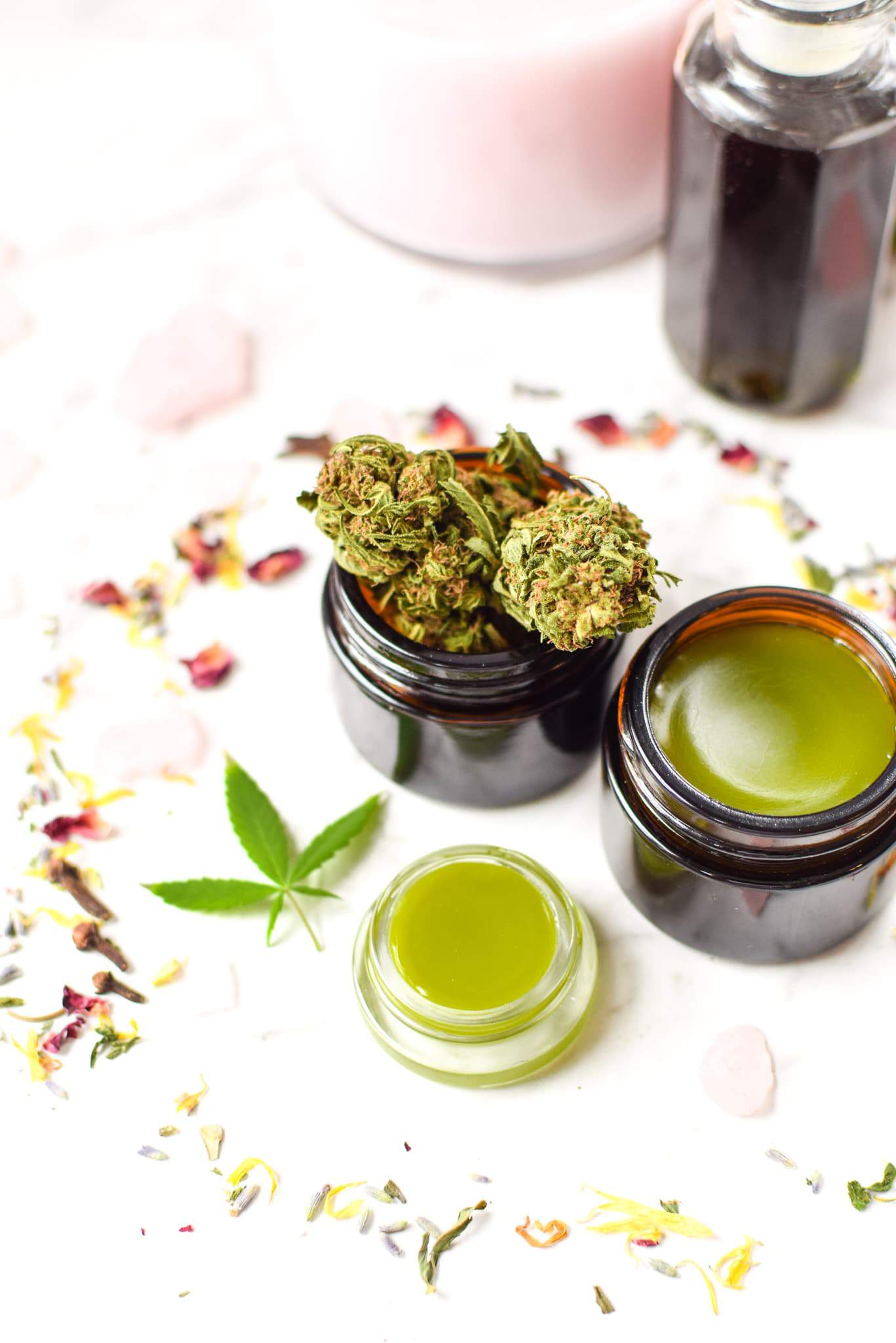
Table of Contents
- Article Features
- Why You Will Love This Recipe
- What You’ll Need
- Step-by-Step Instructions
- Storage Instructions
- Alternate Cannabis Infusion Options
- Benefits of Cannabis Salve
- What Conditions Can It Help?
- Notes and Expert Tips
- Cannabis Salve Recipe with THC or CBD Recipe
- Frequently Asked Questions
- Conclusion
- More Topicals For You
Article Features
- An easy recipe for how to make cannabis salve
- Multiple different infusion options to choose from
- Want to make it easy? Skip the hard work and purchase my cannabis salve or a CBD salve stick – now delivering across the US!
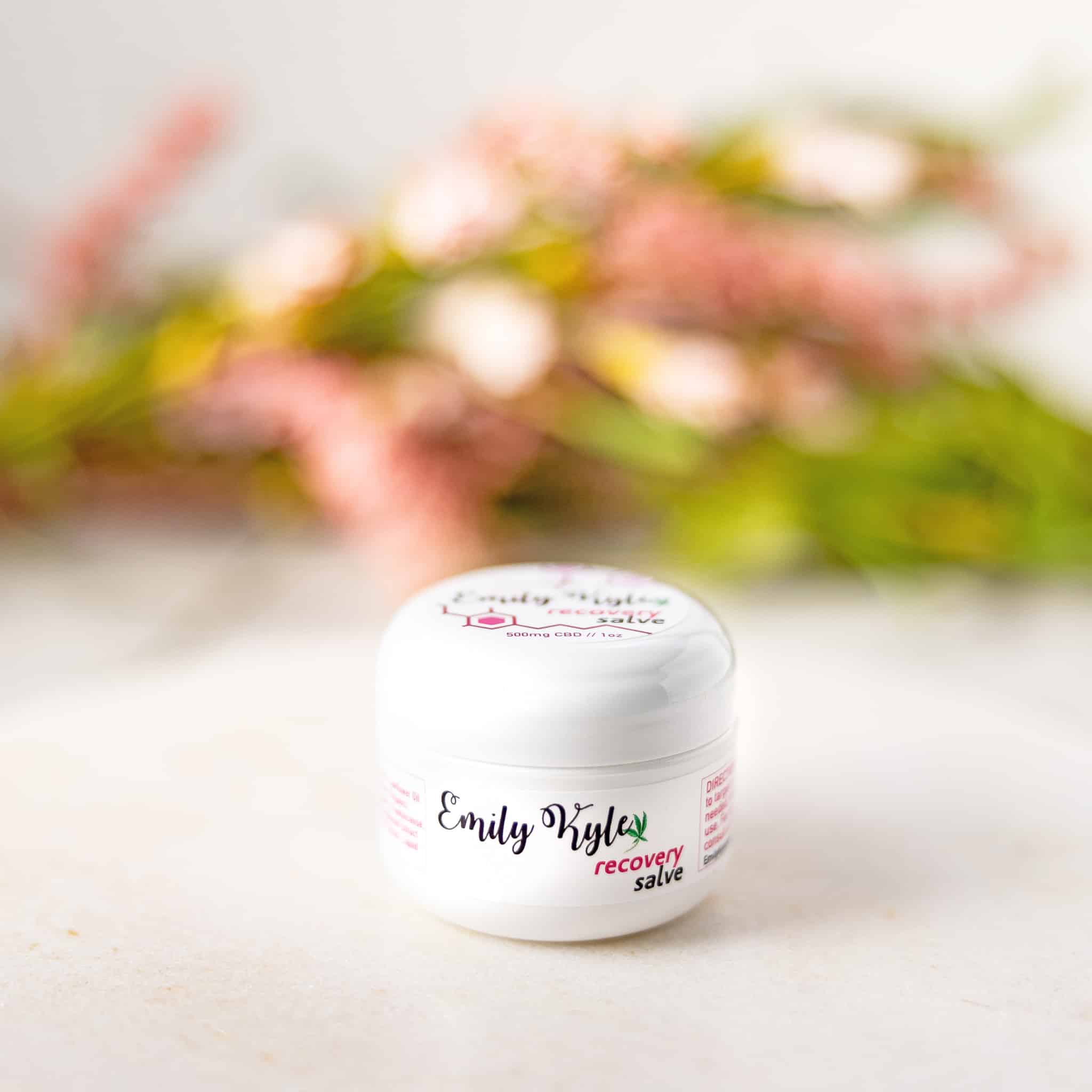
Why You Will Love This Recipe
Cannabis topical products are getting a lot of buzz in my Well With Cannabis Community, and for a good reason!
A salve is an ointment that can promote skin healing and pain relief or be applied as a protective barrier.
A cannabis salve is a salve made with flowers from the cannabis plant, along with other nourishing ingredients, to help moisturize and protect our skin from further damage.
They can be applied directly to the affected area to provide immediate relief from a range of conditions.
In this guide, I will show you how to make a cannabis salve at home in a few simple steps, with multiple infusion options, and show you the many different ways you can customize this recipe to your own personal preferences!
What You’ll Need
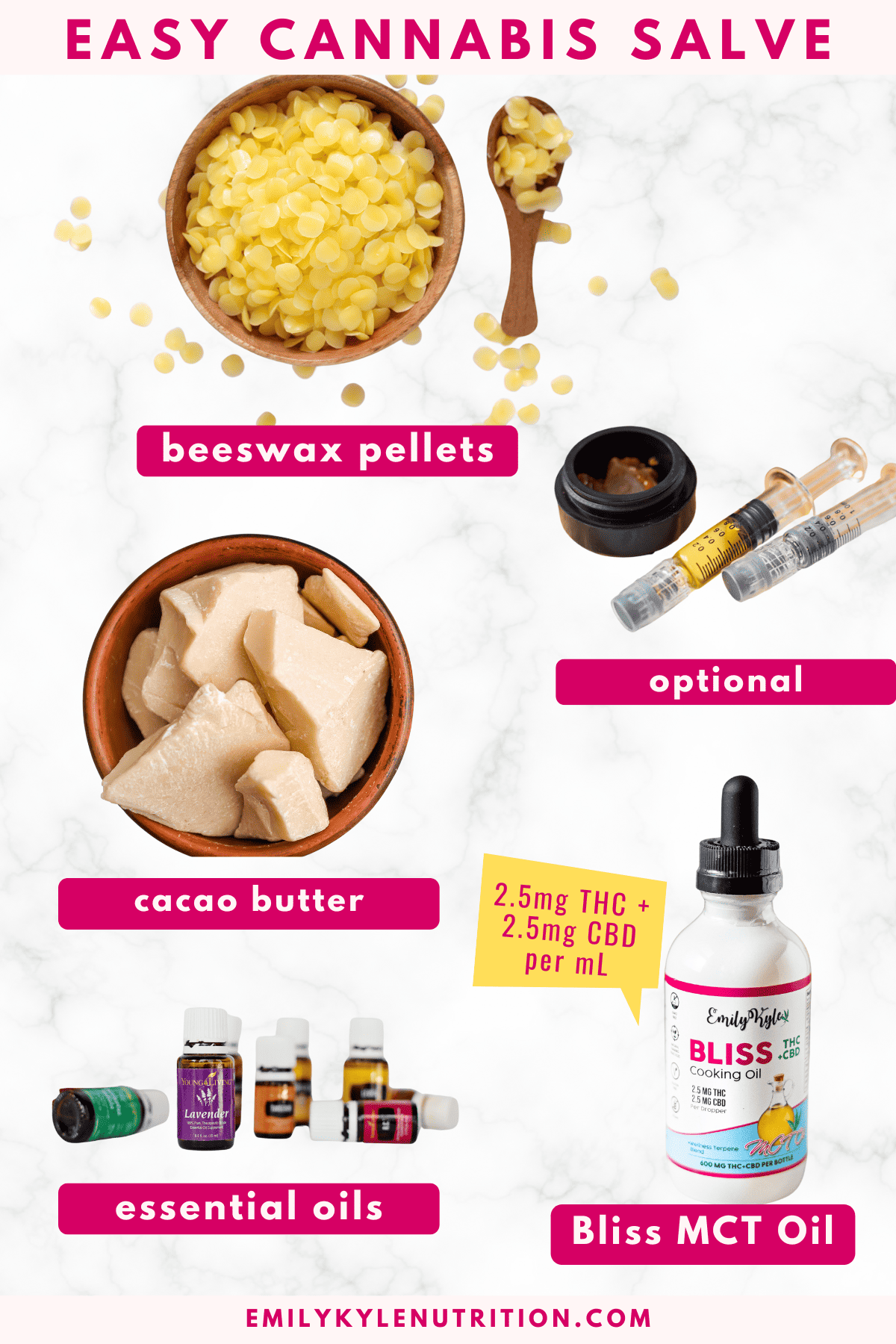
- 2 teaspoons beeswax – I recommend using organic beeswax when possible
- 2 teaspoons cacao butter – not to be confused with cocoa butter! You can get cacao butter right online.
- 8 teaspoons cannabis oil – You can use homemade cannabis oil, my Bliss MCT oil, or concentrates. See the alternative infusion section below for details.
- 5-10 drops essential oils – Feel free to use any combination you enjoy. Just be sure to use skin-safe organic essential oils!
- Optional ingredients – Feel free to add optional vitamin E oil or preservatives like potassium sorbate. You can also add camphor or a method for a cooling effect.
Note: a complete list of ingredients with amounts and printable instructions is located in the recipe card below.
Step-by-Step Instructions
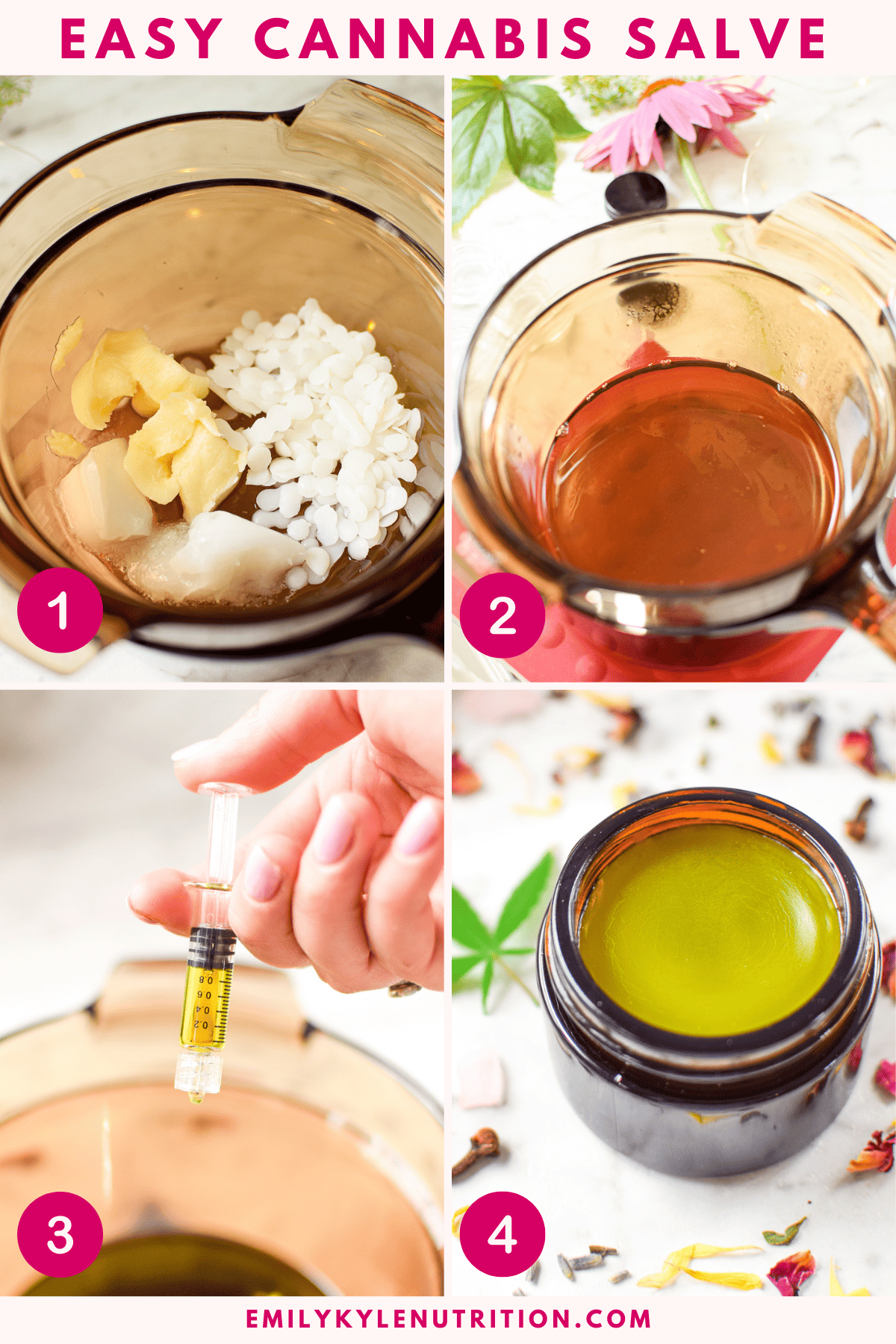
- If you haven’t already, the first step is to choose your infusion method of choice. You can find many infusion options listed below. If needed, prepare your cannabis oil ahead of time.
- Prepare a double boiler with water in the bottom pan and place it over low heat.
- Once the water is boiling, add the beeswax and cacao butter to the top portion of the double boiler and allow them to melt completely.
- Once they have melted, add in the prepared cannabis oil mixture and essential oils. Stir until all of the ingredients are well combined.
- If you are planning on adding a cannabis concentrate or any other additional ingredient, stir it in now and mix until everything is well combined. Then turn off the heat.
- Carefully transfer the hot liquid salve to a small glass jar or storing vessel of choice. You can use a pipette to make this easy.
- Allow the salve to cool to room temperature and then cover tightly with the lid.
- Store your salve in a cool dark place until ready to use.
Note: complete step-by-step printable instructions are located in the recipe card below.
Storage Instructions
Many factors can affect the shelf-life of natural salves, including how you infused the cannabis oil and the additional ingredients that you used.
While this may last a long time stored in a glass jar in a cool dark location, it’s best to use it up within a couple of weeks.
If you can’t use it that fast, you may consider refrigerating it to prevent mold.
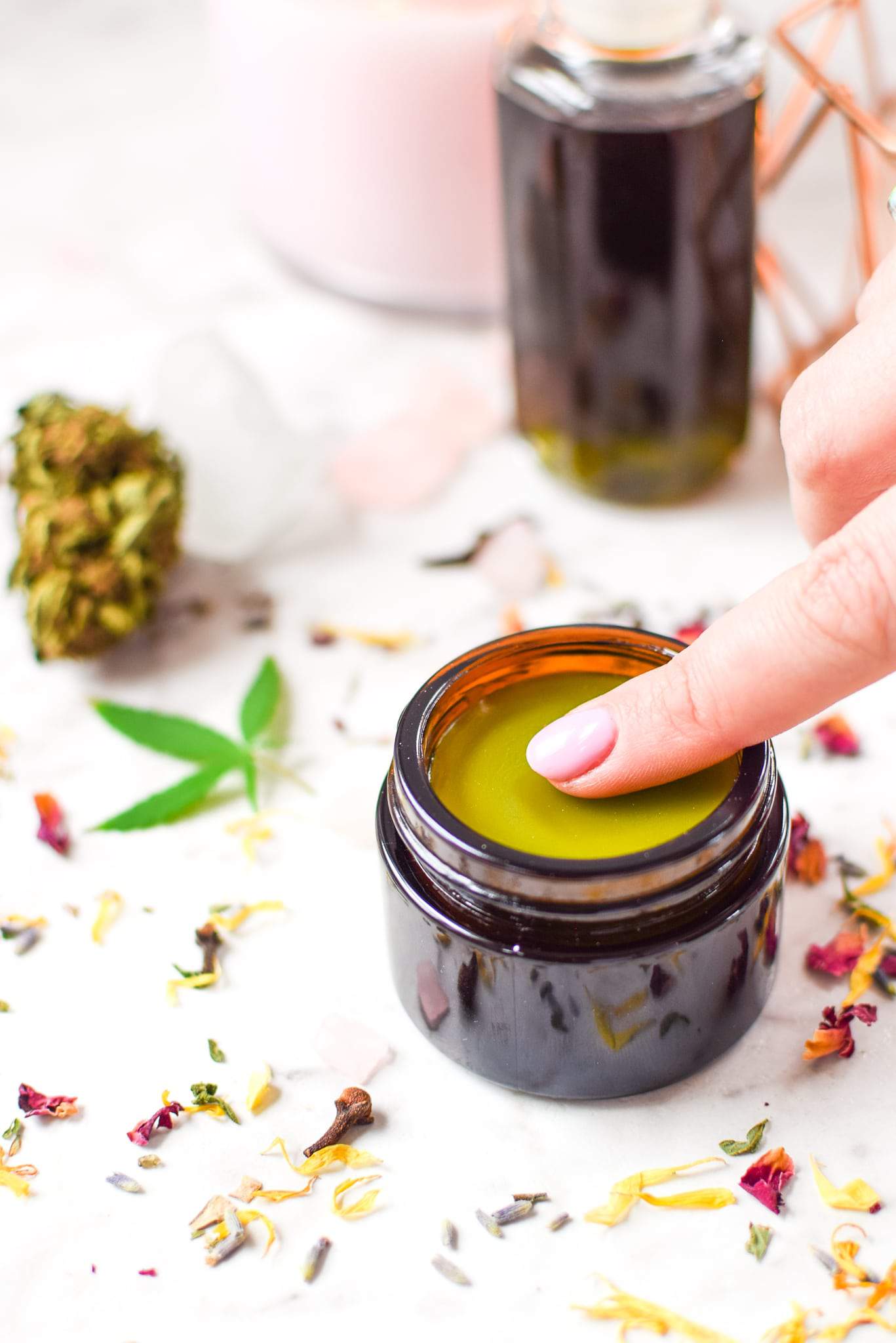
Alternate Cannabis Infusion Options
As with all things cannabis, there are numerous ways to reach the final result.
For this salve, there are many different infusion options you can choose from to make a product with the best results for you and your needs.
Homemade Cannabis Oil
My salve recipe uses this floral cannabis-infused oil recipe as the base, which allows you to infuse in many other botanical ingredients that contribute to a great final product.
You can choose to use a THC flower, CBD flower, or CBG flower to get the benefit of each particular cannabinoid.
You can also use homemade CBD oil, CBG oil, or CBN oil, depending on the effect you are looking for.
You can easily swap the carrier oil in your homemade infusion. Popular carrier oils include:
- Coconut oil
- Olive oil
- MCT oil
- Avocado oil
- Jojoba seed oil or organic jojoba oil
- Sweet almond oil
- Safflower oil
- Hemp seed oil
- Grape seed oil
Store-Bought Cannabis Oil
You can easily make this recipe with high-quality store-bought cannabis oil like the ones for sale in my shop.
They come in a wide variety of strengths, so it might take some experimentation to find which product works best for your needs.
With this method, you can make a salve with your desired cannabinoids like:
Cannabis Concentrate
Having access to raw cannabis flowers is not always possible, which is why I included the option to infuse this salve with cannabis concentrates.
CBD concentrate is legal in most states and can be purchased online, and THC concentrate can be purchased at a dispensary in a legal state.
Concentrates can come in many different forms, including full-extract cannabis oil, also known as FECO.
In a small syringe, you will get anywhere between 500mg-1,000mg of activated CBD or THC in just a small 1mL volume.
This allows you to create a stronger salve without the excess volume of carrier oil.
If you choose to use a concentrate for your salve, I still recommend making the floral-infused oil, with or without cannabis, as this allows you to infuse in more botanical ingredients.
Benefits of Cannabis Salve
Cannabis topicals have many potential health benefits.
These salves are a great alternative to products containing harsh chemicals or prescription medications, which may have unwanted side effects.
Cannabis salves provide quick, localized relief for pain, soreness, or swelling.
The topical application of cannabis, for external use only, can help:
- Skin disorders like eczema or psoriasis
- Relieve chronic pain from inflammatory conditions like rheumatoid arthritis
- To soothe sore muscles, muscle aches, and joint pain
- Soothe menstrual cramps
What Conditions Can It Help?
Homemade cannabis salve may help to relieve some of your most unwanted symptoms, like pain, dry skin, itchiness, and more.
Arthritis
Arthritis is caused by inflammation in the joints and often causes pain, swelling, stiffness, and soreness.
Arthritis usually appears in people over the age of 65 and can limit your range of motion, making it difficult to do things you once loved.
Some studies show that topical cannabis can help to relieve these symptoms1.
Cannabis Salve for Skin Conditions
Millions of people in the US are affected by skin conditions like psoriasis and eczema.
Though the causes of these conditions are still not well-understood, some medical professionals believe that they are an immune system reaction.
Cannabis is thought to help bolster our immune system, protecting us from disease while at the same time suppressing unnecessary immune reactions present in auto-immune disorders2.
Minor Injuries
Scrapes, burns, abrasions, and insect bites are an annoying but inevitable part of life.
The itchiness, stinging, and soreness associated with these minor injuries aren’t life-threatening, but they can be distracting.
Cannabis is now being studied for its wound-healing properties, which means cannabis salve may help relieve your discomfort from minor injuries3.
Notes and Expert Tips
- If you’re making this recipe at home for the first time, feel free to experiment with a non-cannabis-infused oil, like calendula oil, to practice the technique. Good luck!
- Before starting, place the jars you plan on filling onto a baking sheet. This will help prevent them from spilling if you need to move them before they solidify.
- One of the first things you should do is sanitize all of your equipment, jars, and utensils that you will be working with. This can prevent any mold or spoilage in the future.
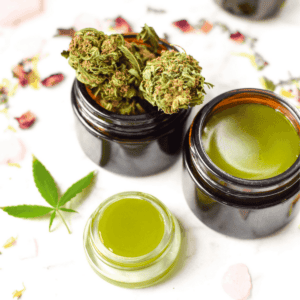
Cannabis Salve Recipe with THC or CBD
Watch The Video
Equipment
What You Need
- 2 teaspoons beeswax
- 2 teaspoons cacao butter
- 8 teaspoons cannabis-infused oil
- 10 drops essential oil of choice
- 1 mL cannabis concentrate optional
Instructions
- If you haven't already, the first step is to choose your infusion method of choice. You can find many infusion options listed above. If needed, prepare your cannabis oil ahead of time.
- Prepare a double boiler with water in the bottom pan and place it over low heat.
- Once the water is boiling, add the beeswax and cacao butter to the top portion of the double boiler and allow them to melt completely.
- Once they have melted, add in the prepared cannabis oil mixture and essential oils. Stir until all of the ingredients are well combined.
- If you are planning on adding a cannabis concentrate or any other ingredient, stir it in now and mix until everything is well combined. Then turn off the heat.
- Carefully transfer the hot liquid salve to a small glass jar or storing vessel of choice. You can use a pipette to make this easy.
- Allow the salve to cool to room temperature and then cover tightly with the lid.
- Store your salve in a cool dark place until ready to use.
Notes
Frequently Asked Questions
Yes! Making a topical cannabis salve at home isn’t for everyone, which is why I am happy to offer my own cannabis salve for sale in my shop. I’ve included ingredients like peppermint and tea tree oil to help open the pores, arnica, and lemongrass to provide deep relaxation, and beeswax and full-spectrum hemp extract to revive the skin. With all-natural ingredients, this salve offers revival and recovery – even if you can never stop moving!
No. While the THC in cannabis is an intoxicating substance, these salves will not have any psychoactive effects because they don’t penetrate the bloodstream. Instead, the compounds found in cannabis, known as cannabinoids, interact with the cannabinoid receptors in your body’s endocannabinoid system.
It is easy to make CBD products at home with CBD flower. This is a good option for those who want all of the benefits of CBD without the excess THC, which is good for some people.
Yes! Transdermal patches are a popular way to medicate. This method holds the product directly onto the skin with small pieces of medical tape. The main difference is how much time the product spends in contact with the skin, increasing the chances that it can be absorbed into the deeper layers of the skin. It is the perfect way to achieve long-lasting relief.
Conclusion
In conclusion, making your own cannabis salve is not just an educational resource but also much fun and a great way to tailor topical applications to your specific needs.
Whether you’re dealing with muscle pain, skin irritation, or just looking for additional ways to utilize cannabis productively, creating your own salve using a slow cooker, or other methods, is a great option.
This step-by-step guide on crafting a CBD salve recipe or a more traditional cannabis salve recipe offers you the freedom to experiment with how much cannabis you use, the kind of oil infusions you prefer, and even the addition of topical lotions to your regimen.
Whether used as a muscle rub or simply to soothe minor irritations, your personal favorite concoction can become a staple in your self-care routine.
Homemade topical remedies like these are a testament to the versatility of cannabis and how it can be a great way to take control of your health and well-being, making your own medicine for a personalized touch.
I’d love to hear about your adventures in salve making! Share your success stories in the comments below and inspire others on their own natural skincare journey.
More Topicals For You
Cannabis Topicals
How To Make Your Own DIY Face Serum with CBD Oil
Cannabis Topicals
How to Make a Basic Cannabis-Infused Balm
Cannabis Topicals
Homemade Cannabis Massage Oil
Cannabis Topicals


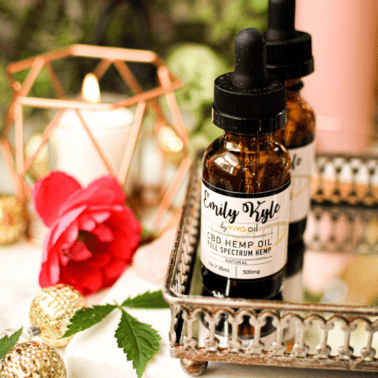
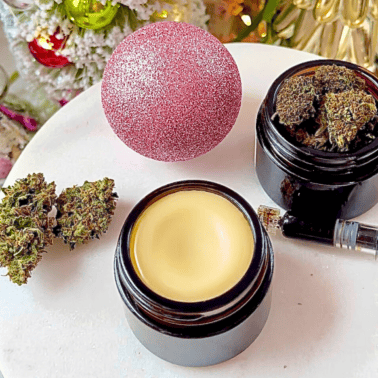
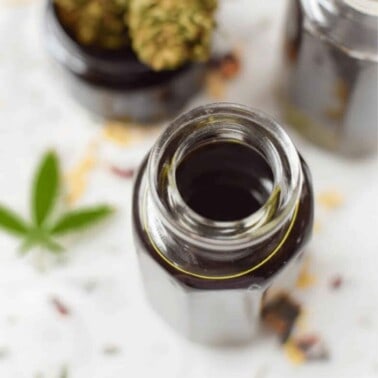
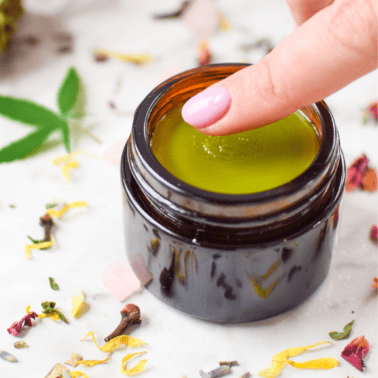
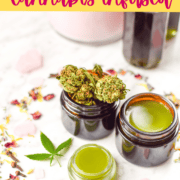








Hello,
I cannot thank you enough for the salve recipe. The very first time I made it, I had a little left in my pot which I put on my eczema that night. Lo and behold, the eczema was completely gone the next morning where I had put the salve. A miracle, after all the different things I had tried on this short of seeing a dermatologist and expensive scips. It hasn’t come back yet either. Will make sure to send some to my brother for his eczema when my sister gets here this year to visit (Germany).
Then, I brought some to my hairdresser who has fought rosacea for years. She called me last week and said she needed some more because it is working better for her than anything she has used, including prescription creams. My friend tried it on her sore neck after yard work and it did the trick for her. Hoping to find out soon how another friend fared with it and her psoriasis. She lives out of town and I gave her some several weeks ago when she was here.
I used MCT oil infused with activated THC for the recipe and added a mold inhibitor to be on the safe side.
Please know that I am very grateful for your website and all those wonderful recipes (friends love those suckers to help sleep).
Thank you, thank you, thank you
❣️❣️❣️❣️❣️
Wow, Karin, I can’t tell you how much your message made my day! 😊 I am so happy to hear how well the salve has worked for you and your loved ones. It’s incredible to know it has brought so much relief, from soothing your eczema to helping your hairdresser’s rosacea and even easing your friend’s sore neck. Stories like yours are why I do what I do, and I truly appreciate you sharing such thoughtful feedback. Thank YOU for taking the time to spread kindness and share your results!
Can’t wait to try this, THANK YOU!
Love this! Let us know how it works for you, Ellen!
Hi, I have access to an autoclave that I use for food. Does anyone have experience with autoclave and canabis.
Hi Kjell. I’d recommend caution, as autoclave settings for cannabis may differ from food. Make sure to research proper temperatures and pressures to avoid compromising quality!
Emily I love your site. Can I substitute cacao butter for another oil in your salve?
Thank You
Hi Heather! You can definitely substitute cacao butter with another oil, like coconut oil, but it may slightly change the texture of the salve. Let us know how it turns out! 😊
How much does this recipe yield (ounces, grams, etc.)? I need to know how many jars to have on hand.
This recipe yields approximately 2 ounces of salve. You can adjust the measurements accordingly to make a larger batch, but it is recommended to use within 3-4 weeks to ensure freshness and potency.
Hi I noticed the shelve life is short
Is there a preservative that could be used ✌️
Hi! Thank you for your question 😊 The shelf life of the cannabis salve can vary depending on the ingredients used and how it’s stored. To extend its shelf life, you can try adding a natural preservative like vitamin E oil, which helps prevent oxidation. Storing the salve in a cool, dark place in an airtight container can also make a big difference. Let us know if you have any other questions! ✌️
I need help I went through cancer?what can I use ?
Thank you for reaching out Lorena, and I’m sorry to hear about your experience with cancer. If you’re looking for guidance on using cannabis, I recommend checking out this detailed article: https://emilykylenutrition.com/how-to-use-cannabis/. It provides helpful information on the different ways to use cannabis, as well as tips to find what might work best for you. A good starting point is to identify the specific ailments you want cannabis to help with, as this can guide you in choosing the right products to experiment with. Hope it helps! Sending healing vibes your way!
The recipe lists cannabis concentrate however, the link doesn’t work. How do we make cannabis concentrate?
Hi Kristina. If you’re looking to make cannabis concentrate at home, I’d recommend trying the Full Extract Cannabis Oil (FECO) method. It’s one of the most effective ways to create a potent, full-spectrum concentrate using minimal equipment. We have a fantastic guide on how to make FECO at home, which you can check out here: https://emilykylenutrition.com/full-extract-cannabis-oil-feco/. This method preserves the full range of cannabinoids and terpenes, making it a great option as a homemade cannabis concentrates. Hope this helps!
Just curious since I found conflicting information searching for it – what’s the difference between the cocoa butter and cacao butter? Why is cacao butter preferred?
I’m so happy you reached out with this question, Ronnie! While both cocoa butter and cacao butter come from the cacao plant, cacao butter is typically considered more raw and minimally processed, preserving more natural nutrients. This might be why you’ve seen it preferred in certain recipes or contexts. Remember, though, both have their unique benefits, so feel free to experiment and find what suits your taste best! 🌿
Can you skip the beeswax and use 100% cocao butter?
Yes JL, you can substitute beeswax with 100% cocoa butter in the cannabis salve recipe. However, keep in mind that cocoa butter has a different texture and melting point, which might affect the final consistency of the salve. It’s worth experimenting to find the right balance that works for you!
Used Cocoa by mistake for salve did I ruin it
Using cocoa in your salve shouldn’t ruin it, Gary! Cocoa can add a nice texture and moisturizing properties. However, if you’re concerned about the effects, you might want to test a small amount on your skin first. Let us know how it turns out!
Hello , thank you so much for the great information. I’m wanting to make the salve for my grandfathers arthritis. I have a few questions. How to do make the cannabis flower? Do you just put it in a food processor? Also how many milligrams of the are in this recipe? Thank you Rhiannon
Hi Rhiannon! I’m glad you found the information helpful. To make the cannabis flower for your salve, you’ll want to decarboxylate the flower first, which activates the cannabinoids. Using a food processor to break it down further isn’t necessary.
As for dosage, you can use our online calculator to calculate the strength of your salve based on the specific potency of your cannabis. I recommend checking it out for precise calculations. Best of luck with your salve for your grandfather!
Have you ever added Magnesium to your Cannabis Salve? What are your thoughts on doing this?
Absolutely, GladysMae! I’ve experimented with adding magnesium to my cannabis salve, and I found it to be a beneficial addition. Magnesium is known for its muscle-relaxing properties and can enhance the soothing effect of the salve, making it great for those tense areas. However, like any ingredient, it’s important to ensure it dissolves evenly to maintain the salve’s consistency. 😊 Feel free to try it out and see how it works for you!
Thank you for sharing. I made topical oil for pain it is first attempt and your guide is awesome. Pain in knees not completely gone but pain tolerance is better.
Thanks for sharing
Thank you for your feedback, Jamie! We’re so happy the guide was helpful for your first attempt! Even if the pain isn’t completely gone, it’s great that you’re seeing improvements in your pain tolerance. Keep experimenting, and I hope you continue to find relief!
I am making salve for the first time.
Using THC herb for this. After I decarb it Looks like I need to make an infused oil but I am lost. lol. Can someone guide me so this salve has half a chance please?
I suffer from degenerative bone disease and nerve pain and would really like something that will help. It seems no matter how many articles I read – I can’t seem to put all the steps and instructions in a comprehensible order for myself. *sigh*
Hi Marieanne. It’s great to hear that you’re taking the first steps in making your own cannabis salve! I completely understand how the process can feel overwhelming, but we’re here to help guide you through it step-by-step.
First, you’ve got the right idea starting with decarboxylation. This is crucial for activating the THC in your herb. Here’s a simple guide to follow:
1. **Choose Your Oil**: Decide on a carrier oil like coconut oil, olive oil, or MCT oil. Each has its own benefits, but they all work well for infusing cannabis.
2. **Infuse the Oil**: Full guide here: Easy Cannabis Coconut Oil Recipe
– **Method**: Use a slow cooker.
– **Process**: Combine your decarbed cannabis and oil into a jar. This guide will help you determine your ratios: Cannabis Flower-to-Oil Ratio Guide & Printable Chart
– **Duration**: Let it infuse for 4 few hours.
3. **Strain the Oil**: After infusing, strain the mixture through a cheesecloth or fine mesh strainer to remove the plant material. You’ll be left with your infused oil.
4. **Make the Salve**:
– **Ingredients**: Melt beeswax and cacao butter in a double boiler.
– **Combine**: Add your infused oil and any essential oils you prefer (lavender or eucalyptus are great options).
– **Finish**: Stir until well combined, then pour into jars and let it cool.
Given your specific needs with degenerative bone disease and nerve pain, this salve could offer some relief. If you have any more questions or need further assistance, don’t hesitate to ask. You’re doing great, and I hope this helps!
Hi, Can you please tell me if I can use feco to make a pain relief cream? What would the ratios be? And can I add magnesium chloride flakes? I am VERY new to this. I have all the ingredients, I’m just not sure how to start. I also have a slow cooker, can I use that?? I’m in Australia, so very limited here with getting help. Thank you 😊
Hi Cathy! You can absolutely use FECO (Full Extract Cannabis Oil) to create a pain relief cream. Typically, you’ll want between 500mg-1,000mg of activated CBD or THC.
Adding magnesium chloride flakes is a great idea as it’s known for its muscle-relaxing properties. Start with a small amount, such as a teaspoon per cup of carrier oil, and adjust according to your needs.
Since you’re new to this, using a slow cooker is a fantastic way to ensure even heat distribution while infusing your oils. Just make sure to keep it on a low setting to avoid overheating the mixture.
I understand how challenging to find help in Australia is, so we have an online forum with members from all over the world that come together to help each other on their cannabis journeys. We’d love to have you join us: Well With Cannabis Community
Remember, starting is the hardest part, so take your time and don’t be afraid to experiment. Good luck, and enjoy making your pain relief cream! 😊
Made my first salve it came out great. Getting ready to do more. Purchased 2 oz jars
Hi there Wendy 👋 That’s fantastic news! I’m thrilled to hear that your first salve turned out great. It’s always exciting to see hard work pay off, isn’t it? Those 2 oz jars are perfect for salves – they’re the ideal size for personal use and for sharing with friends and family. Here’s to many more successful salve-making sessions!
Love your site. I have a1000mg total the infusion 4oz. For medical use. Could I make a salve out of it? It does have added sugar
I’m thrilled that you’re finding value in our site 😊 Absolutely, you can turn your infusion into a salve. The sugar won’t affect the process, but please note that it may add a slightly sweet scent to your final product. Just make sure to blend it well with the other ingredients. Please don’t hesitate to share your experiences and results with us – we’d love to hear how your salve turns out!
Emily could you explain the purpose of de-carbing? Is doing it in the oven the most preferred way?
Thank you
Hi Joyce! De-carbing, short for decarboxylation, is a process that involves heating cannabis to activate its compounds, such as THC. It’s commonly done in the oven by spreading the cannabis evenly on a baking sheet and baking it at 240º for a specific duration. This method is the most widely preferred by many. However, there are alternative methods like using an instant pot or a specialized decarboxylation device. It ultimately depends on personal preference and equipment availability. You can read more about decarboxylation here: Easy Beginner’s Guide to Cannabis Decarboxylation Hope this helps!
how much cbd oil could i substitute for 1oz cbd isolate in a recipe? I recently purchased the ardent Fx after reading your reviews of many of the machines. Have you ever made salve in the ardent? I’d like to try.
Hi there, Kendra! 😊 Thank you so much for reaching out and for your kind words about my reviews. I’m thrilled to hear that you’ve purchased the Ardent FX! Substituting CBD oil for CBD isolate can vary depending on the concentration of your oil. If your oil is 1000mg per 30ml, then 1oz of isolate (about 28000mg) would be equivalent to roughly 28 bottles of your oil. However, this can vary, so please do check the concentration of your specific product. As for making salve in the Ardent FX, I haven’t personally tried it yet, but I would just make an infusion and then follow this recipe.
Hello! I am trying this for the first time, though I do make. Regular salve for my excema and usually add in vitamin E oil and Neem oil. How much vitamin E would you add to this recipe and what do you think about adding neem oil too?
Hi Angie. For this recipe, I would recommend adding 1 teaspoon of vitamin E oil. As for neem oil, it can be a beneficial addition as it has anti-inflammatory properties that may help with eczema. I would suggest starting with 5 drops. You can adjust both of these to fit your desired texture of the salve. I hope this gives you a good start!
Any advice making a RSO salve using coconut oil & beeswax. What would be the proportions. What essential would you to better absorb it. Thank you.
Hi Thomas. A good starting point is 2 cups of coconut oil, 1/3 cup of beeswax and 1ml RSO. This is just a basic recipe and you may need to adjust the ratios depending on your personal preferences. I hope this helps!
How many jars will this recipe measurement produce?
2 teaspoons beeswax
2 teaspoons cacao butter
8 teaspoons cannabis oil
Hi Paul. Altogether, that’s 12 teaspoons of ingredients, give or take a little bit. 1 ounce is equivalent to 6 teaspoons so this recipe yields approximately 2 ounces of salve. If you’re using standard 1-ounce jars, you would end up with 2 jars of salve. If you’re using smaller containers, like 0.5-ounce jars, you would get 4 jars. I hope this helps!
Good morning, I want to make the cannabis salve. With your recipe, would be ok once the solution cools down to whip it? Also how will it last in a cool dry place opposed to storing in the fridge?
A side question, which strain would you recommend for anxiety, sativa and indica. Thank you.
Hi RM Joyner! We haven’t experimented with whipping this recipe, but I don’t see why you couldn’t. I recommend taking a small amount and trying to whip that first to see if you like the final product. The salve may last a long time stored in a glass jar in a cool dark location, but if you can’t use it within a few weeks, you may want to consider freezing it to prevent any mold.
And for anxiety, unfortunately, there is no one-size-fits-all answer when it comes to picking the right strain of cannabis. Many people feel unwanted effects from Sativa strains, notably increased anxiety. For this reason, it is a good idea to avoid Sativa-dominant strain types when getting started using cannabis for varying anxiety levels. Consumers generally love Indica varieties because of their deep relaxation and sedative effects. Popular Indica strains include Northern Lights, OG Kush, and Hindu Kush. I hope this helps!
I have made two batches of coconut oil, cannabis, salve. The first one was a little more like lotion, but still definitely salve. The second one accidentally got cooked at a higher temperature when she was in the oil. The final product looks like the first, But the consistency is more like I expected in a salve, but the second batch seems to be more oily when rubbing it on the skin. It seems to take longer to rub it in, which means more massaging, but not what I expected. What could have caused the oiliness of the second batch ?
Hi Jacquelyn. Did you follow this Cannabis Salve recipe or did you use only use coconut oil? Coconut oil by itself can be difficult to absorb into the skin and may take up to 5-10 minutes. If you followed the recipe, you can try adding in additional beeswax to thicken the salve. I hope this helps!
Hi Emily
Love your site and ur wisdom. I will be attempting to make a CBC salve with isolate…can u tell me how I put the ingredients together using isolate please and thank you ?
Hi Jill. You’ll want to incorporate the isolate into a liquid portion of the recipe, a fat if possible. This will help more evenly distribute the isolate through the whole recipe, ensuring there are no clumps or any uneven distribution.
If you find your isolate is hard to work with, gently warm it over the stove or in the oven until it is liquid enough to mix in. **Don’t use a microwave to heat it as you run the risk of potentially destroying your cannabinoids.
I hope this helps!
What’s the best strain, and type of cannabis, (FECO, Salve, Tincture) to treat Leukemia? sores are coming out of the arm.
Hey Mike! I apologize, but I am not a doctor and cannot give you medical advice for treating cancer. Have you considered reaching out to a medical marijuana doctor in your state?
How much potassium sorbate would you add?
Hey Jessica, I think just 1/4-1/2 teaspoon should be fine in this recipe 😀
If i were to add vitamin E oil, how much would i add?
Hello Shannon! I don’t have experience working with vitamin E oil, so I don’t know how much you need to be effective, but I don’t think it would hurt to add up to 5mL to the current recipe 🙂 Let us know how it turns out for you if you give it a try!